
Muricidae is a large and varied taxonomic family of small to large predatory sea snails, marine gastropod mollusks, commonly known as murex snails or rock snails. With over 1,700 living species, the Muricidae represent almost 10% of the Neogastropoda. Additionally, 1,200 fossil species have been recognized. Numerous subfamilies are recognized, although experts disagree about the subfamily divisions and the definitions of the genera. Many muricids have unusual shells which are considered attractive by shell collectors and by interior designers.

The aperture is an opening in certain kinds of mollusc shells: it is the main opening of the shell, where the head-foot part of the body of the animal emerges for locomotion, feeding, etc.

The knobbed whelk is a species of very large predatory sea snail, or in the US, a whelk, a marine gastropod mollusk in the family Busyconidae, the busycon whelks.

Busycotypus canaliculatus, commonly known as the channeled whelk, is a very large predatory sea snail, a marine prosobranch gastropod, a busycon whelk, belonging to the family Busyconidae.

Busycon is a genus of very large edible sea snails in the subfamily Busyconinae. These snails are commonly known in the United States as whelks or Busycon whelks. Less commonly they are loosely, and somewhat misleadingly, called "conchs".
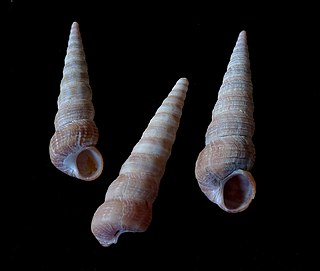
A spire is a part of the coiled shell of molluscs. The spire consists of all of the whorls except for the body whorl. Each spire whorl represents a rotation of 360°. A spire is part of the shell of a snail, a gastropod mollusc, a gastropod shell, and also the whorls of the shell in ammonites, which are fossil shelled cephalopods.
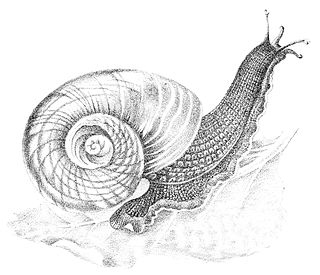
Paryphanta busbyi is a species of large predatory land snail, a terrestrial pulmonate gastropod mollusk in the family Rhytididae.

The gastropod shell is part of the body of a gastropod or snail, a kind of mollusc. The shell is an exoskeleton, which protects from predators, mechanical damage, and dehydration, but also serves for muscle attachment and calcium storage. Some gastropods appear shell-less (slugs) but may have a remnant within the mantle, or in some cases the shell is reduced such that the body cannot be retracted within it (semi-slug). Some snails also possess an operculum that seals the opening of the shell, known as the aperture, which provides further protection. The study of mollusc shells is known as conchology. The biological study of gastropods, and other molluscs in general, is malacology. Shell morphology terms vary by species group.
Edgbastonia coreena is a species of small freshwater snails which have an operculum, aquatic gastropod mollusks in the family Tateidae.
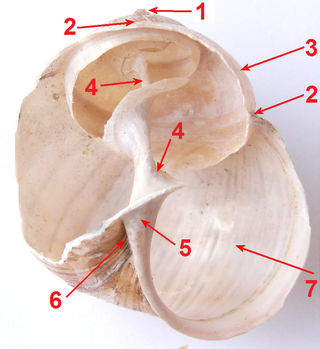
The columella or pillar is a central anatomical feature of a coiled snail shell, a gastropod shell. The columella is often only clearly visible as a structure when the shell is broken, sliced in half vertically, or viewed as an X-ray image.

Calliostoma ligatum, common name the blue top snail, is a small prosobranch trochid gastropod mollusk in the family Calliostomatidae, the Calliostoma top snails.
The following is a glossary of common English language and scientific terms used in the description of gastropods.

The marine snail Norrisia norrisii is a medium-sized gastropod mollusk within the family Tegulidae. It has several common names, including Norris's top snail, Norris's topsnail, norrissnail, smooth brown turban snail, or kelp snail. It was first described by G.B. Sowerby I under the name Trochiscus norrisii. It is the only species in the genus Norrisia.
Tritia denticulata is a species of sea snail, a marine gastropod mollusk in the family Nassariidae, the Nassa mud snails or dog whelks.

Nucella lamellosa, commonly known as the frilled dogwinkle or wrinkled purple whelk, is a species of sea snail, a marine gastropod mollusk in the family Muricidae, the murex snails or rock snails. This species occurs in the eastern Pacific Ocean, its range extending in the intertidal zone from the Aleutian Islands southward to central California.

Nucella ostrina, the northern striped dogwinkle, is a species of sea snail, a marine gastropod mollusk in the family Muricidae, the murex snails or rock snails. Other common names for this mollusk include emarginate dogwinkle, short-spired purple dogwinkle, striped dogwinkle, ribbed dogwinkle, emarginate whelk, ribbed rock whelk, rock thais, short-spired purple snail and rock whelk.

Cerithium caeruleum, the Cerith sand snail, is a species of sea snail, a marine gastropod mollusk in the family Cerithiidae. Cerithium caeruleum, also be called Cerithium caeruleum G.B. Sowerby II, 1855 generally can be found in large populations on intertidal rocky shores and are covered by a thin layer of sediments. They have large and solid shells, and their radula ribbon robust long about one-fifth the shell length. This species lives in the planktonic stage from 90 to 120 days and has a seven-year life history. This common intertidal species is confined to east Africa, Madagascar, and the Arabian Peninsula and is unlikely to be confused with any other Cerithium species. It is distinguished by its squat, knobby shape; and as indicated by its name, caeruleum, a grayish blue color with spiral rows of black tubercles.
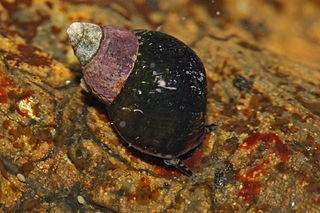
Littorina scutulata is a species of sea snail, a marine gastropod mollusk in the family Littorinidae, the winkles or periwinkles.
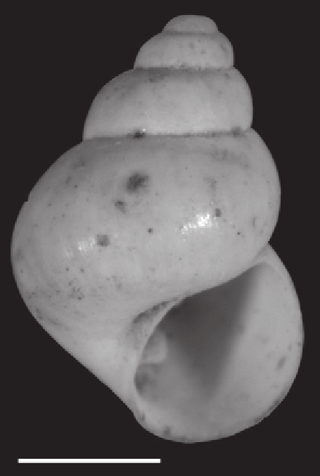
Marstonia comalensis is a species of minute freshwater snail with a gill and an operculum, an aquatic gastropod mollusk or micromollusk in the family Hydrobiidae. It is found in south central Texas, United States.

Lamellaria perspicua, commonly known as the transparent lamellaria, is a species of small, slug-like sea snail, a marine gastropod mollusc in the family Velutinidae. It is native to the northeastern Atlantic Ocean and the Mediterranean Sea, where it feeds on colonial ascidians.

















